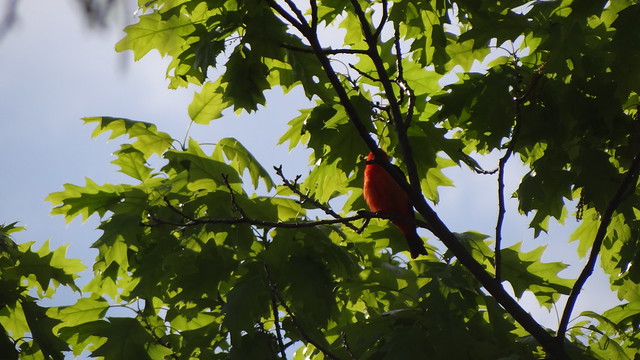It seems like every spring is marked by a new fad in the world of digital birding.
This year, it’s the “orange variant” of the Scarlet Tanager that has the internet abuzz. I can’t turn the machine on any more without reading about this “form,” and there is an abundance of photographic material out there purporting to show such individuals. Just google it.
There is no doubt that some males of this species in definitive alternate plumage are less scarlet than others; have a look at Larry Sansone’s photograph of a decidedly ochre-toned individual in Beadle and Rising’s Photographic Guide, for example. Rising comments that this bird falls notably towards the orange end of “the scale”; the implication is, correctly and appropriately, that there is a more or less continuous range of color to be observed, from the dull orange of some males to the classic blazing red of others.
Yes, they vary: They vary “considerably,” in the authoritative words of Robert Ridgway, “being sometimes of a flame-scarlet or almost orange hue.” But that doesn’t mean there is any definable “variant” among them, any more than there is an identifiable “yellow variant” of the American Robin or the Summer Tanager — two other species in which the reddish parts of males’ plumage can differ in brightness and saturation.
When most of us see a dull adult male Scarlet Tanager, we’re delighted and intrigued, and tend to say something like “Why, look, there’s a dull adult male Scarlet Tanager!” without elevating that individual bird to the status of “variant.”
Most of the photos being posted to the internet now, though, are not of adult tanagers at all. Image after image of these “orange variants” shows a first-alternate male Scarlet Tanager, readily aged by the molt limits in the wing. And many of those birds are indeed duller orange-red than the name “scarlet” might suggest.
Entirely as expected.
BNA tells us that first-alternate males are “orange-red to scarlet.” Dwight describes them as “sometimes pale or mixed with orange.” It’s simply normal — for lack of a better word — for some ten-month-old male Scarlet Tanagers to be orangish.
Where did the need to assign these birds to a class of “variants” come from? The obvious answer is provided by a painting in the first edition of the Sibley guide, a dull tanager captioned “variant adult male breeding.”
In a process of productive misreading, Sibley’s perfectly unexceptionable adjective “variant” — meaning “different” — has apparently come to be re-analyzed as the tendentious noun “variant,” a definable kind departing from the normal, a “morph.” But what the guide is describing, and what birders are observing, is simply individual variation, with some birds more orange, some birds more scarlet, some birds more yellow.
I’m not suggesting that we stop looking close at male Scarlet Tanagers, and I’m not suggesting that anyone stop “posting” photos of particularly bright or particularly dull or otherwise remarkable birds. But when we encounter a bird that strikes us as oddly colored, maybe we should remember that variation doesn’t always make a variant.



